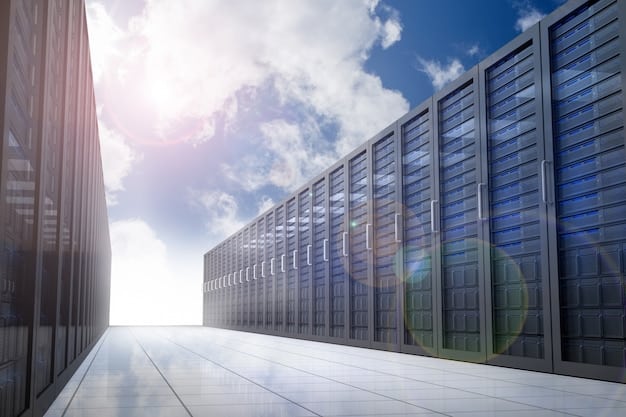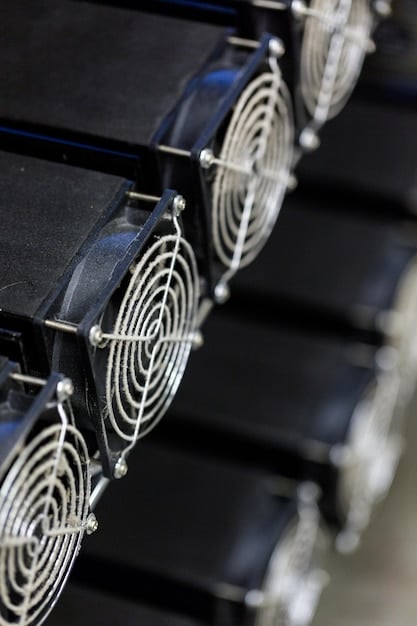Sustainable Tech: Reducing Data Center Carbon Footprint in the US

Sustainable tech is revolutionizing US data centers by implementing innovations like renewable energy, advanced cooling systems, and virtualization to significantly reduce their carbon footprint.
The relentless growth of data consumption has made data centers essential, but their energy-intensive operations contribute significantly to carbon emissions. The good news? Sustainable tech: innovations reducing carbon footprint in US data centers are emerging as a game-changer.
Understanding the Carbon Footprint of US Data Centers
Data centers, the backbone of the digital age, consume vast amounts of energy. Understanding their carbon footprint is the first step toward sustainability. Let’s delve into the specifics.
Energy Consumption Metrics
Data centers require immense power to operate servers, cooling systems, and other infrastructure components. This consumption is often measured through Power Usage Effectiveness (PUE).
Environmental Impact Factors
The choice of energy sources, cooling methods, and waste management practices all play a role in the environmental impact of data centers. Sustainable changes can create significant impact.

Key factors determining the environmental impact include:
- Energy Sources: The reliance on fossil fuels vs. renewables.
- Cooling Systems: Efficiency of the methods used to dissipate heat.
- E-Waste Management: Responsible disposal and recycling of outdated equipment.
Ultimately, reducing the carbon footprint involves minimizing energy use and maximizing the use of environmentally friendly resources. Data centers prioritizing sustainability are already making significant advances.
Renewable Energy Integration in Data Centers
One of the most impactful changes in reducing emissions is the integration of renewable energy sources. This approach shifts data centers away from fossil fuels and towards cleaner, sustainable alternatives.
Solar and Wind Power Adoption
Solar and wind power are becoming increasingly viable options for powering data centers. Large-scale installations can provide a significant portion of their energy needs.
Challenges and Solutions
Integrating renewables presents challenges such as intermittency and grid stability. Innovative solutions are vital to overcome these obstacles.
Overcoming these issues involves:
- Energy Storage: Using batteries to store excess power for later use.
- Smart Grids: Enhancing grid infrastructure to manage fluctuating power inputs.
- Power Purchase Agreements: Locking in long-term renewable energy contracts.
By addressing these challenges, data centers can significantly reduce their reliance on fossil fuels and minimize their environmental impact.
Advanced Cooling Technologies
Cooling systems are the next significant area for sustainable innovation. Traditional air conditioning consumes substantial energy, prompting the development of more efficient alternatives.

Liquid Cooling Systems
Liquid cooling directly cools servers, providing more efficient heat transfer compared to air. This can substantially reduce energy consumption.
Free Cooling Methods
Free cooling leverages natural resources like water or outside air to cool data centers. This reduces the need for energy-intensive mechanical cooling.
Here are some notable free cooling techniques:
- Direct Air Cooling: Using outside air when the temperature is low enough.
- Evaporative Cooling: Utilizing water evaporation to cool the air.
- Water-Side Economizers: Using cool water from natural sources to dissipate heat.
These strategies significantly reduce the energy needed for air conditioning, leading to lower electricity bills and smaller carbon footprints.
Virtualization and Server Optimization
Beyond energy sources and cooling, optimizing server utilization is essential. Virtualization and other strategies reduce the physical hardware required, leading to lower emissions.
Benefits of Virtualization
Virtualization consolidates multiple virtual machines onto a single physical server, improving resource use and reducing the total number of servers needed.
Energy-Efficient Hardware
Using hardware designed for energy efficiency also makes a significant difference. This includes servers, storage, and networking equipment.
Strategies for optimizing server efficiency:
- Right-Sizing Servers: Deploying servers that match the workload requirements.
- Defragmentation: Regularly defragmenting storage devices improves efficiency.
- Automated Shutdown: Shutting down idle servers during off-peak hours.
Efficiently managing server infrastructure is vital in lowering energy consumption.
Data Center Location and Design
The location and design of data centers also play a crucial role in sustainability. Picking the right location and implementing smart designs can significantly reduce environmental impact.
Strategic Location Choices
Locating data centers in areas with cooler climates or access to renewable energy sources reduces cooling costs and emissions.
Green Building Standards
Designing data centers to meet green building standards such as LEED ensures energy efficiency and resource conservation.
Key design considerations include:
- Efficient Layout: Optimizing the layout to minimize energy waste.
- Smart Lighting: Using LED lighting and motion sensors to reduce energy use.
- Green Roofs: Implementing green roofs to provide insulation and reduce stormwater runoff.
Thoughtful location and design considerations are essential for creating sustainable data centers.
Policy and Regulation Driving Change
Government policy and industry regulations are essential to promoting sustainable practices. These mandates encourage data centers to adopt environmentally friendly technologies.
Government Incentives and Mandates
Incentives such as tax credits and grants encourage the adoption of sustainable technologies. Mandates set standards for energy efficiency and emissions reductions.
Industry Standards and Certifications
Standards such as ISO 14001 and certifications like Energy Star for Data Centers help maintain and validate sustainable practices. These provide accountability in environmental efforts.
Regulations often address various factors:
- Energy Efficiency: Establishing benchmarks for PUE and energy consumption.
- Emissions Standards: Setting limits for greenhouse gas emissions.
- E-Waste Management: Mandating responsible disposal and recycling.
Effective policies ensure that data centers work towards a sustainable future, contributing to broader environmental goals.
| Key Point | Brief Description |
|---|---|
| ⚡ Renewable Energy | Using solar and wind power reduces reliance on fossil fuels. |
| 💧 Liquid Cooling | Efficiently cools servers, reducing energy needed for air conditioning. |
| ☁️ Virtualization | Consolidates virtual machines on fewer physical servers. |
| 🏢 Strategic Location | Choosing cooler climates and renewable energy access is essential. |
FAQ
▼
The carbon footprint of a data center refers to the total greenhouse gas emissions produced directly and indirectly from its operations, including energy usage and cooling.
▼
Renewable energy sources such as solar and wind produce electricity with little to no greenhouse gas emissions, thus lowering the carbon footprint compared to fossil fuels.
▼
Liquid cooling systems use fluids to dissipate heat from servers more efficiently than air cooling, reducing the energy needed for cooling and thus lowering emissions.
▼
Virtualization allows multiple virtual machines to run on a single server, optimizing resource usage and reducing the overall number of physical servers required, lowering energy consumption.
▼
Government policies such as incentives, tax credits, and regulations encourage data centers to invest in and adopt sustainable technologies, driving down carbon emissions.
Conclusion
As data demands grow, adopting sustainable tech in US data centers is no longer optional but essential. Innovations like renewable energy, advanced cooling, and virtualization are paving the way for a greener, more sustainable digital infrastructure. By embracing responsible technologies and practices, data centers can minimize their carbon footprint and contribute to a healthier planet.





